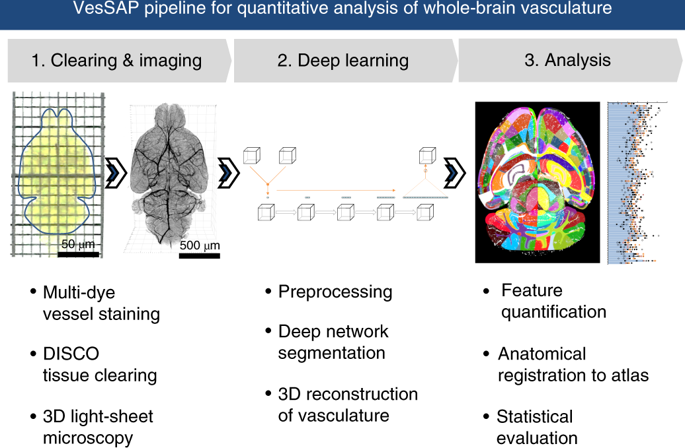Nature Methods ( IF 36.1 ) Pub Date : 2020-03-11 , DOI: 10.1038/s41592-020-0792-1 Mihail Ivilinov Todorov 1, 2, 3 , Johannes Christian Paetzold 4, 5, 6 , Oliver Schoppe 4, 5 , Giles Tetteh 4 , Suprosanna Shit 4, 5, 6 , Velizar Efremov 4, 7 , Katalin Todorov-Völgyi 2 , Marco Düring 2, 8 , Martin Dichgans 2, 8, 9 , Marie Piraud 4 , Bjoern Menze 4, 5, 6 , Ali Ertürk 1, 2, 8

|
Tissue clearing methods enable the imaging of biological specimens without sectioning. However, reliable and scalable analysis of large imaging datasets in three dimensions remains a challenge. Here we developed a deep learning-based framework to quantify and analyze brain vasculature, named Vessel Segmentation & Analysis Pipeline (VesSAP). Our pipeline uses a convolutional neural network (CNN) with a transfer learning approach for segmentation and achieves human-level accuracy. By using VesSAP, we analyzed the vascular features of whole C57BL/6J, CD1 and BALB/c mouse brains at the micrometer scale after registering them to the Allen mouse brain atlas. We report evidence of secondary intracranial collateral vascularization in CD1 mice and find reduced vascularization of the brainstem in comparison to the cerebrum. Thus, VesSAP enables unbiased and scalable quantifications of the angioarchitecture of cleared mouse brains and yields biological insights into the vascular function of the brain.
中文翻译:

全小鼠脑血管系统的机器学习分析。
组织透明方法无需切片即可对生物样本进行成像。然而,对大型三维成像数据集进行可靠且可扩展的分析仍然是一个挑战。在这里,我们开发了一个基于深度学习的框架来量化和分析脑血管系统,称为血管分割和分析管道(VesSAP)。我们的管道使用卷积神经网络(CNN)和迁移学习方法进行分割,并达到人类水平的准确性。通过使用 VesSAP,我们在将 C57BL/6J、CD1 和 BALB/c 小鼠大脑登记到 Allen 小鼠大脑图谱后,在微米尺度上分析了它们的血管特征。我们报告了 CD1 小鼠继发性颅内侧支血管化的证据,并发现与大脑相比,脑干的血管化减少。因此,VesSAP 能够对透明小鼠大脑的血管结构进行无偏且可扩展的量化,并产生对大脑血管功能的生物学见解。











































 京公网安备 11010802027423号
京公网安备 11010802027423号